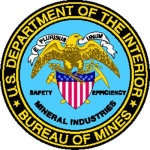- Отрасли: Mining
- Number of terms: 33118
- Number of blossaries: 0
- Company Profile:
The U.S. Bureau of Mines (USBM) was the primary United States Government agency conducting scientific research and disseminating information on the extraction, processing, use, and conservation of mineral resources.
Founded on May 16, 1910, through the Organic Act (Public Law 179), USBM's missions ...
A general name used for consolidated rocks composed of silt and/or clay and of the associated materials which, when mixed with water, form mud; e.g., shale, mudstone, and calcilutite. The term is equivalent to the Greek-derived term "pelite." Etymol: Latin lutum, mud. Also spelled lutyte.
Industry:Mining
A general name used for consolidated sedimentary rocks composed of rounded or angular fragments coarser than sand (granules, pebbles, cobbles, boulders, or gravel or rubble); e.g., conglomerate, breccia, and calcirudite. The term is equivalent to the Greekderived term, psephite. Etymol: Latin rudus, crushed stone, debris, rubble.
Industry:Mining
A general term applied to a soil that consists primarily of organic matter such as peat soil and muck soil.
Industry:Mining
A general term applied to copper deoxidized with phosphorus. The most commonly used deoxidized copper.
Industry:Mining
A general term applied to crystals whose shapes have been acquired or modified by mechanical or chemical processes acting on the original forms.
Industry:Mining
A general term applied to rocks made up of spherules. It includes such textures as oolitic, pisolitic, spherulitic, variolitic, orbicular, etc.
Industry:Mining
A general term applied to steels of low carbon content that do not temper.
Industry:Mining
A general term applied to swarms of opaque, microscopic grains in rocks, esp. as rims that develop mainly on biotite and hornblende phenocrysts in volcanic rocks, apparently as a result of post-eruption oxidation and dehydration. Opacite is generally supposed to consist chiefly of magnetite dust. Compare: ferrite.
Industry:Mining
A general term applied to the treating of ore to recover gold and silver therefrom.
Industry:Mining
A general term covering a wide variety of mass-movement landforms and processes involving the downslope transport, under gravitational influence, of soil and rock material en masse. Usually the displaced material moves over a relatively confined zone or surface of shear. The wide range of sites and structures, and of material properties affecting resistance to shear, result in a great range of landslide morphology, rates, patterns of movement, and scale. Landsliding is usually preceded, accompanied, and followed by perceptible creep along the surface of sliding and/or within the slide mass. Terminology designating landslide types generally refers to the landform as well as the process responsible for it; e.g., rockfall, translational slide, block glide, avalanche, mudflow, liquefaction slide, and slump.
Industry:Mining
